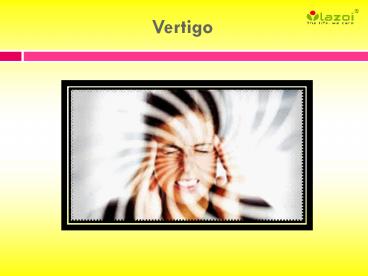Vertigo : Causes, Symptoms, Diagnosis and treatment (1) - PowerPoint PPT Presentation
Title:
Vertigo : Causes, Symptoms, Diagnosis and treatment (1)
Description:
Vertigo is the sensation that you or your environment is moving or spinning. It differs from dizziness in that vertigo describes an illusion of movement. When you feel as if you yourself are moving, it's called subjective vertigo, and the perception that your surroundings are moving is called objective vertigo. – PowerPoint PPT presentation
Number of Views:309
Title: Vertigo : Causes, Symptoms, Diagnosis and treatment (1)
1
Vertigo
2
Vertigo
- Vertigo is a sense of rotation, rocking, or the
world spinning, experienced even when someone is
perfectly still. Its a sense of feeling off
balance, or dizziness. - Vertigo is sometimes considered as fear of
height, must fear of height is called as
acrophobia - It is common with all ages, but it can be caused
in people aged 65 years or old. - Vertigo is costly caused by any inner ear
problem, but certain causes such as dehydration
or decrease in blood pressure can make any person
dizzy.
3
Symptoms
- Symptoms for vertigo may include
- Spinning
- Tilting
- Swaying
- Unbalanced
- Pulled to one direction
- Other symptoms may also include
- Feeling nauseated
- Vomiting
- Abnormal or jerking eye movements (nystagmus)
- Headache
- Sweating
- Ringing in the ears or hearing loss
4
Diagnosis of vertigo
- Diagnosis of vertigo may start with the detailing
of the recent illness with the doctor. - The doctor may undergo a physical examination ,
which may ask the patient how the dizziness makes
them feel. Which can distinguish between
different dizziness - MRI or Ct scans may be done of the brain and
inner ear to exclude any possibilities of stroke - Nystagmus test Vertigo may provoke different eye
movement, certain test is done to diagnose that
which include - Electronystagmography (ENG) can electronically
record the nystagmus. The patient wears a headset
that places electrodes around the eyes. The
device measures eye movements. - Videonystagmography (VNG) is a newer technology
can provide a video recording of the nystagmus.
5
Diagnosis of vertigo
Continue
- Head impulse test- The patient is asked to fix
the gaze toward the nose. If the patient can fix
the gaze, then the test is negative, otherwise
vertigo can be suspected. - Rombergs test- If the person becomes unsteady
when the close their eyes, who remains steady
with eyes open may be suspected with vertigo. - Unterbergers test- The patients are asked to
march for 30 seconds, with their eyes closed. If
they rotate sideways, then vertigo may be
suspected.
6
Causes of vertigo
- BPPV- It means benign paroxysmal positional
vertigo. BPPV occurs when tiny calcium particles
(canaliths) clump up in canals of the inner ear.
The inner ear sends signals to the brain about
head and body movements relative to gravity. It
helps to keep our balance. - BPPV can occur for no known reason and may be
associated with age. - Meniere's disease. This is an inner ear disorder
thought to be caused by a buildup of fluid and
changing pressure in the ear. It can cause
episodes of vertigo along with ringing in the
ears (tinnitus) and hearing loss. - Vestibular neuritis or labyrinthitis. This is an
inner ear problem usually related to infection
(usually viral). The infection causes
inflammation in the inner ear around nerves that
are important for helping the body sense balance
7
Causes of vertigo
Continue
- Other rare caused may include
- Head or neck injury
- Brain problems such as stroke or tumour
- Certain medications that cause ear damage
- Migraine headaches
8
Risk factors of vertigo
- Certain risk factors may include
- Any head injury can increase the risk
- Different medications such as ant seizures
medications, blood pressure medications or even
aspirin can increase the risk. - Anything that increase the risk of stroke,
increases the risk of vertigo - Older age increases the risk of vertigo, and
women have higher risk than men. Mostly older
women.
9
Treatment
- Treatment of vertigo
- Vertigo can be resolved without ant treatment,
but some vertigo with any bacterial infection may
need medication - Drugs can relieve symptoms of some kinds of
vertigo, for example, vestibular suppressants or
anti-emetics to reduce motion sickness and
nausea. - Patients with acute vestibular disorder linked to
a middle ear infection may be prescribed steroids
(such as prednisone), antiviral drugs (such as
acyclovir) or antibiotics (such as amoxicillin) - If the vertigo is caused by BPPV, a technique
known as the Epley maneuver is used. This is also
known as canalith repositioning. Here, the
particles are moved from the inner part to a open
area known as vestibular, where it can be easily
absorbed. - Prescription drugs, such as diazepam or lorazepam
can be used to relieve the dizziness experienced
with Ménière's disease - Certain medications, correct treatment and a
quality life style with certain restriction can
control vertigo to much extent. Its not a
life-threatning disease and in much cases doesnt
have any further complications.
10
CONNECT WITH US
- Logon to
- www.lazoi.com
- Like us on Facebook
- https//www.facebook.com/LazoiTheLife
- Follow us on Twitter
- https//www.twitter.com/lazoithelife
- Follow us on Pinterest
- https//www.in.pinterest.com/lazoithelife































